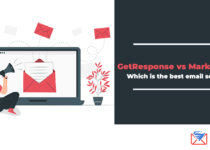GetResponse vs ConvertKit: Which is better?
 Marketing automation is crucial to creating more streamlined and measurable marketing campaigns, and help you grow your sales and profit. It allows you to delegate menial tasks such as sending the right emails to subscribers at the right time and collecting subscribers.
Marketing automation is crucial to creating more streamlined and measurable marketing campaigns, and help you grow your sales and profit. It allows you to delegate menial tasks such as sending the right emails to subscribers at the right time and collecting subscribers.
If your focus is growing your business or service, you need to invest time and effort in executing marketing campaigns, interpreting them, and finding ways to improve them.
ConvertKit and GetResponse are marketing automation tools that can make the job much easier for you. Both are two of the best and most popular automation softwares in the market so you can’t really go wrong with using either for your business. However, of course there will be differences.
In this post, we compare GetResponse vs ConvertKit, two powerful automation tools to help you see which one suits your needs better.
ConvertKit
ConvertKit is a full-featured email service provider (ESP) created by Nathan Barry. Thanks to its ease of use, automation, and other features. It’s one of the fastest growing email marketing companies around. It also offers customizable sign-up forms and landing pages to help bring in more email subscribers.
Best features of ConvertKit
- Simple and intuitive platform
ConvertKit, as a cloud-based email tool, takes the “keep it simple, stupid!” approach. True enough, it is one of the most accessible marketing automation platforms to use. The site’s clean UI makes it easy to understand the data presented to you on the screen.
While the drag-and-drop builder is common among automation tools to help you build your follow-up emails for your sales funnel, ConvertKit has arguably the easiest builder. Its easy-to-follow logic of “if this, then that” recipe lets you set up multiple automation recipes you can combine to keep your audience engaged.
Some tools offer drag-and-drop builders for composing your emails complete with pre-made templates so you don’t have to create from scratch. While having this option allows you to send emails that are eye-catching to your subscribers, ConvertKit forgoes beautiful designs for their email and instead focus on text-based emails.
Not offering an email builder encourages content creators to focus on sharing their message to their subscribers rather than on the design. More importantly, text-based email converts much better compared to HTML emails.
- Better personalization
When building your email list, you may find yourself sending the same emails to everyone. Since they signed up to your list, it is easy to assume that they would like to receive all your emails. However, this isn’t always the case.
Thankfully, ConvertKit allows you to identify what people want to receive from you by tagging each one. You can tag your subscribers by using the tool’s Automation feature. You can tag them according to the action they took on your email. If they click on a particular link on your email, for instance, you can set the tool to group them in a single tag.
This feature is helpful when identifying the emails they want to receive from you. Once they click on the link, ConvertKit will group them to a tag. You then avoid putting off your readers with emails about something they’re not interested in.
ConvertKit’s Pricing Plans
ConvertKit’s pricing depends on the number of subscribers you have. Their paid plans start at $29/month for 1,000 subscribers or fewer. Their $49/month plan supports between 1,001-3,000 subscribers while the $79/month carries 3,001-5,000 subscribers.
People with over 5,000 subscribers will need a custom quote from ConvertKit. All plans include the same features, such as unlimited forms, automation workflows, campaigns, and subscriber tagging.
GetResponse
GetResponse is an all-in-one email marketing software. If you’re looking for a more robust and comprehensive marketing automation platform, GetResponse is the better option.
It is one of the most established email marketing tools in the industry and is one of the first that adopted marketing automation features in its email platform. GetResponse has added more than enough features over the years to make it the only tool you need to grow your business. (READ More: GetResponse Review)
Get our FREE course on AFFILIATE MARKETING straight to your inbox
This course includes video tutorials on how to do email marketing.
Best features of GetResponse
- Ideal for Webinar Marketing
Launching a webinar is an excellent way to onboard leads into becoming customers or clients of your business. Instead of sending them emails or writing blog posts, you can instantly engage with them by scheduling a time and date for everyone to join so you can show them how your product works.
During the product showcase, you can field in questions and answer their concerns in real-time to convert and sell your products much better.
GetResponse offers a complete suite of webinar marketing features and options on top of its capabilities as an email marketing platform. From the platform, you can set up the webinar URL, the time and date of the webinar, and the password to keep it private (although you can leave it blank to make the webinar available for all).
You can then use GetResponse’s form builder to collect emails of people interested in joining your webinar. Choose from pre-made templates for your opt-in forms, so you don’t have to start from scratch.
Even if your attendees are not in front of their desktop, they can still join the webinar from their iOS or Android phones using the GetResponse Webinar app. Besides sharing your screen for your presentation, you can further engage with your audience by using polls to gather feedback and enable the chat feature among others.
Once the webinar is over, you can follow them up using trigger-or-time-based campaigns for those who attended.
- Works very well with e-commerce shops
GetResponse works best with small businesses and startups like e-commerce shops. GetResponse knows the growing demand of these businesses as they continue to expand in time. For online stores, the tool is more than equipped to take your e-commerce marketing to the next level! (READ More: How to integrate GetResponse with Shopify)
The tool integrates well with most e-commerce platforms like PrestaShop, Magento, WooCommerce, and more. Once you connect GetResponse with these platforms, you can access its data, such as the most popular products and others.
Using this information, you can develop automated email campaigns to upsell and recommend related products to increase your sales for your e-commerce marketing strategy.
Using GetResponse’s Recommendations block on your email automatically analyzes products you can suggest to previous buyers. Drag the block to the email, set it up to generate recommendations to your past customers, and get them to repurchase them from your transaction email.
Abandoned carts are one of the unavoidable issues that e-commerce shops encounter. There are many reasons consumers abandon their carts and some of them are beyond your control. What you can do, however, is to recover abandoned carts using GetResponse.
You can set up the perfect time when the potential customer will receive the reminder in their email. To help aid in increasing your conversion rate, you can add a discount at the end of the campaign to sweeten the deal.
- Manages and nurtures your leads
If you want to keep a better track of your sales pipeline, set it up using GetResponse, and score your leads. Similar to HubSpot CRM, you can customize the entries in your customer journey so you can organize your leads and find opportunities you can capitalize on.
You can edit each subscriber by entering the date of closing the deal with clients or the date when you plan on engaging with them to turn them into clients. You can also add notes on each subscriber to help define each lead and understand what else you need to do to convince them to purchase.
Finally, develop multi-channel marketing using GetResponse’s CRM and e-marketing solutions to roll out a concerted and well-coordinated marketing campaign in a single place.
GetResponse’s Pricing Plans
Like ConvertKit, GetResponse is a premium email service that starts at $15/month for 1,000 subscribers or less. The Email plan gives you access to all its e-marketing solutions from autoresponders to marketing automation workflows.
The Pro plan is the most popular plan at $49/month for 5,000 subscribers or fewer. It offers more comprehensive features for both email marketing and automation functions. The webinar marketing (starting at 100 attendees) and CRM features are available in the Pro plan and above.
The Max plan costs $165 for 10,000 subscribers and less while the Enterprise plan costs $1,165 for over 100,000 subscribers.
The Verdict: GetResponse vs ConvertKit
ConvertKit and GetResponse are very different tools despite their similarities as an email marketing platform.
If you’re a blogger or content creator who focuses on building a personal brand from his or her website or blog, then ConvertKit is the best solution for you. The tool is straightforward and straightforward, making it ideal for bloggers who want a tool they can use out of the box.
The easy-to-use UI allows users to get acquainted with the tool naturally and by experimenting with it themselves. While you can criticize ConvertKit for being too simple, it’s because the tool is not created to answer the needs of your business.
If you are growing your business and need to worry about the aspect of your business outside marketing automation, then GetResponse provides an all-in-one marketing tool for you. It not only offers you comprehensive marketing automation features but also makes available adjacent tools that complement your email marketing.
The webinar marketing tool in GetResponse allows you to engage with your leads and connect with them on a level that no email can do. The CRM feature gives you a better understanding of your sales funnel so you can push the needle and get them to buy from you.


